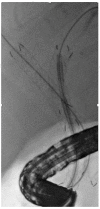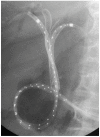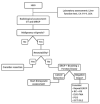Personalized Endoscopy in Complex Malignant Hilar Biliary Strictures
- PMID: 33572913
- PMCID: PMC7911877
- DOI: 10.3390/jpm11020078
Personalized Endoscopy in Complex Malignant Hilar Biliary Strictures
Abstract
Malignant hilar biliary obstruction (HBO) represents a complex clinical condition in terms of diagnosis, surgical and medical treatment, endoscopic approach, and palliation. The main etiology of malignant HBO is hilar cholangiocarcinoma that is considered an aggressive biliary tract's cancer and has still today a poor prognosis. Endoscopy plays a crucial role in malignant HBO from the diagnosis to the palliation. This technique allows the collection of cytological or histological samples, direct visualization of the suspect malignant tissue, and an echoendoscopic evaluation of the primary tumor and its locoregional staging. Because obstructive jaundice is the most common clinical presentation of malignant HBO, endoscopic biliary drainage, when indicated, is the preferred treatment over the percutaneous approach. Several endoscopic techniques are today available for both the diagnosis and the treatment of biliary obstruction. The choice among them can differ for each clinical scenario. In fact, a personalized endoscopic approach is mandatory in order to perform the proper procedure in the singular patient.
Keywords: confocal laser endomicroscopy; endoscopic retrograde cholangiopancreatography; endoscopic ultrasound; malignant hilar strictures; peroral cholangioscopy; personalized endoscopy; plastic biliary stents; self-expandable metal stents.
Conflict of interest statement
Professor Guido Costamagna: Consultant for and food and beverage compensation from Cook Medical, Boston Scientific, and Olympus. Dr. Ivo Boškoski: Consultant for Apollo Endosurgery, Cook Medical, and Boston Scientific; board member for Endo Tools; research grant recipient from Apollo Endosurgery; food and beverage compensation from Apollo Endosurgery, Cook Medical, Boston Scientific, and Endo Tools. All the other authors have nothing to declare.
Figures











References
-
- Koshiol J., Ferreccio C., Devesa S.S., Roa J.C., Fraumeni J.F. Schottenfeld and Fraumeni Cancer Epidemiology and Prevention. 4th ed. Oxford University Press (OUP); Oxford, UK: 2017. Biliary Tract Cancer.
-
- Bismuth H., Corlette M.B. Intrahepatic cholangioenteric anastomosis in carcinoma of the hilus of the liver. Surg. Gynecol. Obstet. 1975;140:170–178. - PubMed
Publication types
LinkOut - more resources
Full Text Sources
Other Literature Sources

